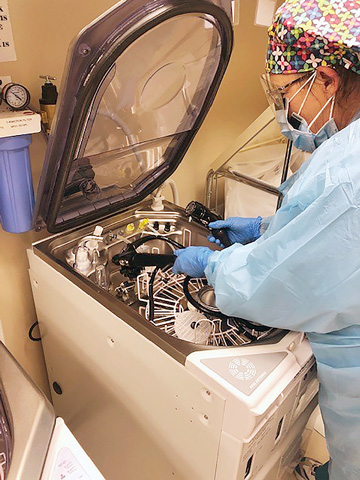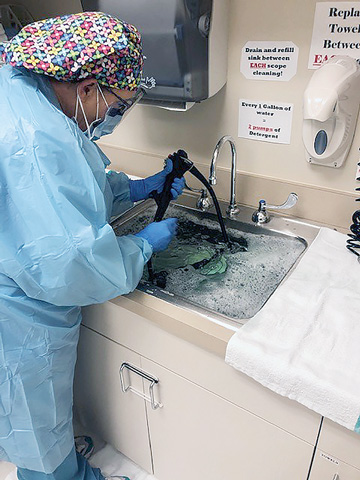- Home
- Article
Scope Reprocessing Starts at the Bedside
By: Randall Rentschler, RN
Published: 5/9/2020
Follow the essentials of endoscope disinfecting, drying and storage.
Endoscopes must be long, narrow and flexible to do their jobs. This also makes them extremely delicate and notoriously difficult to clean. They can break in transport from the procedure room to the sterile processing area and can wear down from daily rounds of high-level disinfection. That’s why a staff trained in how to properly clean, hang and dry these expensive devices is critical to making sure they’re always in good working order and available for whenever your physicians need them next.
Dirty-to-clean workflow
The first step to guaranteeing an endoscope is properly disinfected the next time it’s used is to begin treating it immediately after it’s been withdrawn from the patient. Bedside cleaning in the endoscopy suite should consist of wiping down the external surface of the scope with a soap and water solution, and aspirating the cleaning solution through the scope’s channels. Some cleaning solutions come pre-wetted, so you can perform this immediate-use cleaning without having to add water.
After scopes have been treated at the bedside, place them in a cinch bag or closed container to make sure they don’t get damaged during transport to the reprocessing area. Closed containers or bags also protect staff from exposure to the dirty instruments.
Once the scopes arrive in the dirty side of the decontamination room, they’re placed in a sink, where the scope and channels are manually brushed, washed and rinsed again. Next, the scope is pressure-tested for leaks. At this point, the scopes are ready to be put into an automatic endoscopic reprocesser (AER) for high-level disinfecting.
There are numerous manufacturers of AERs and several options of disinfectants they use. Our facility’s AER uses an environmentally friendly buffered peracetic acid solution, a combination of vinegar and hydrogen peroxide. In my opinion, it’s a better option than activated glutaraldehyde, a particularly noxious solution used in many AERs that emits fumes requiring stringent venting requirements due to employee exposure concerns. Our AERs are outfitted with radio-frequency identification (RFID) scanning technology, which allows us to know who cleaned specific scopes, when the cleaning was done and which patient the scopes were used on. Some models track that automatically, while others require you to fill the information in on a log. Either system works well. The machine prints out a form with a unique RFID number on it, and we place a patient sticker on the printout.
After scopes are removed from the AER, move them to the clean side of the reprocessing area where they should be flushed with 70% isopropyl alcohol and purged with air. Some AER’s perform this step automatically, but it’s still a good idea to perform a manual alcohol push. This helps to ensure scopes will be completely dry when they enter the storage cabinets, which should be designed to make sure they stay that way. After the scopes are dry, perform an adenosine triphosphate (ATP) test to verify cleanliness and measure microbial contamination before hanging them in storage cabinets. Our existing cabinets constantly circulate air through the storage chamber to keep the endoscopes dry. It’s an effective solution, but we might also add an external component that filters air from a compressor into hanging scopes to ensure residual moisture that can lead to biofilm development does not remain in internal channels.
A note about duodenoscopes, which are commonly used for Endoscopic Retrograde Cholangiopancreatography (ERCP). These devices are particularly difficult to clean and disinfect due to a complicated design of an elevator channel at the distal end that houses a guidewire and catheter. In December 2019, the FDA approved the first completely disposable duodenoscope, but we believe the model is not yet cost effective. We’re planning on buying a new duodenoscope with a disposable end cap designed to eliminate the need to clean the problematic elevator component. The rest of the scope can be reprocessed appropriately utilizing the same cleaning process as standard GI scopes, making it a potentially safer option than a standard scope.

Society of Gastroenterology Nurses and Associates (SGNA) guidelines state that flexible endoscopes cannot be stored for more than seven days without having to be reprocessed again before reuse. These guidelines, based on studies that show bacteria can grow in scopes with moisture inside them that have been hanging for more than a week, have become the industry standard.
Of course, following these guidelines can be problematic. Scopes are delicate and expensive, and putting them through a reprocessor every seven days increases their exposure to high-level disinfectant, which can decrease the instrument’s lifespan. It also increases personnel costs, and the costs associated with increased use of the automated endoscope reprocessor (AER) and the solutions that go into it.
Fortunately, there’s an alternative. You can perform your own study to look at what bacterial growth, proteins left by bacteria or other potential contamination remain in stored scopes over a longer time period. You can use adenosine triphosphate (ATP) testing to check for residual blood and bioburden in an endoscope’s channels, thus indirectly measuring microbial contamination. If your study shows scopes stay clean and growth-free for longer than a week, CMS will allow you to hang them for the duration your research deems safe (up to 30 days) without having to undergo reprocessing. The key here is having your testing documented and strong enough to stand behind.
— Randall Rentschler, RN
Fast and safe

Continuous training for GI staff is essential to keep your cleaning and high-level disinfection processes working well. We have a dedicated GI technician, but our entire staff attends scope reprocessing training. In addition to GI scopes, our facility uses flexible urology, GYN and intubation scopes. Even though we’re sterilizing those scopes and not high-level disinfecting them, I think it’s important for the entire staff to be trained in the same cleaning concepts and techniques.
Our scope oversight coordinator conducted trainings to check off all the steps in the cleaning process, and my GI coordinator will essentially repeat the training yearly. I conduct the training for my scrub tech, endo tech and GI coordinator.
Efficient scope care is essential, but what’s most important is that the scopes you have are high-level disinfected by a well-trained staff, and dried and stored using products that have the best available features and technologies available. OSM
.svg?sfvrsn=be606e78_3)
.svg?sfvrsn=56b2f850_5)